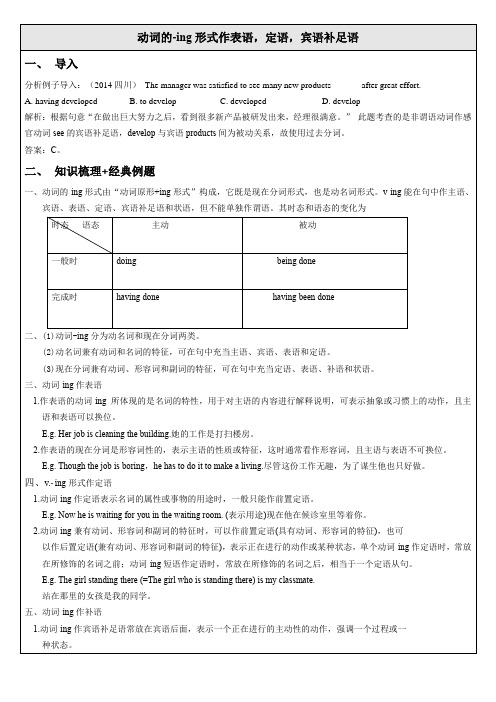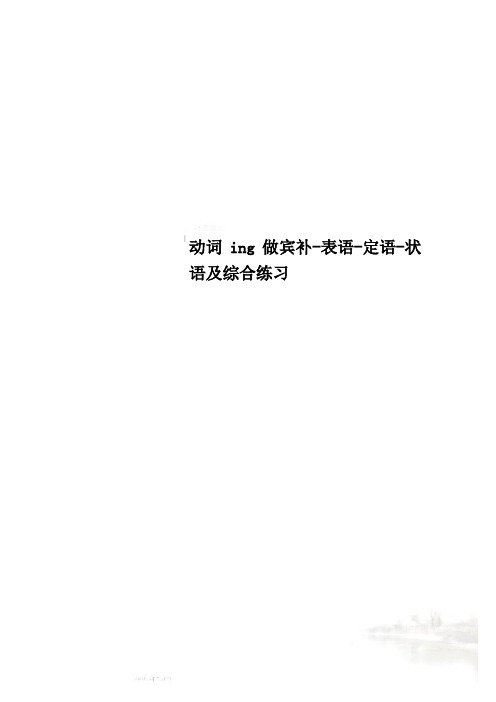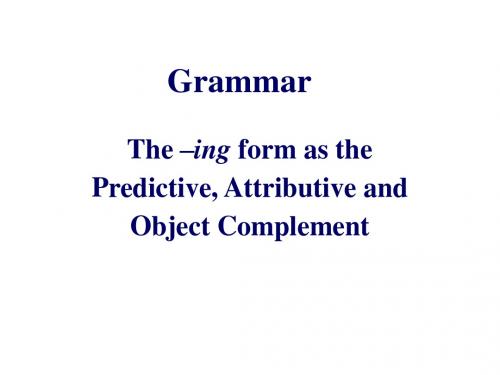动词ing形式作表语和宾补
必修4动词-ing形式作表语、定语、宾语补足语和状语

年级高一学科英语版本人教实验版内容标题必修4 Unit 3 A taste of English humor动词-ing形式作表语、定语、宾语补足语和状语编稿老师林静【本讲教育信息】一. 教学内容:动词-ing形式作表语、定语、宾语补足语和状语二. 知识精讲(一)动词的ing形式作表语1. 动名词作表语一般表示抽象的、习惯性的行为,这时主语与表语的位置可以互换。
Her duty is taking care of the babies.照看婴儿是她的职责。
Our job is playing all kinds of music.我们的工作就是演奏各种音乐2. 现在分词作表语,表明的是主语的性质与特征,相当于形容词,可有比较级形式,亦可被very, quite,so等副词修饰,这时主语与表语的位置不可互换The music they are playing sounds exciting.他们演奏的音乐是如此令人兴奋The film we saw last night is quite moving.我们昨晚看的电影十分感人。
(二)动词的ing形式作定语1. 动名词作定语,表示该名词的用途或与其有关的动作,通常只能放在所修饰的名词前。
a walking stick手杖 reading room 阅览室 washing machine洗衣机2.现在分词作定语,说明所修饰的名词正在进行的动作或存在的状态,现在分词与所修饰的名词具有逻辑上的主谓关系,可换成定语从句来表达,单个的现在分词作定语常置于被修饰的名词前,现在分词短语作定语须置于被修饰的名词后。
Nobody can stop the running horse(=the horse that is running).没人能阻止那匹奔跑的马。
The student making the experiment(=who is making the experiment) is our monitor.正在做实验的那个学生是我们的班长。
动词的-ing形式作表语,定语,宾语补足语

1)位于感官动词后(see,hear,feel,smell,watch,find,notice等)。
E.g.I felt somebody patting me on the shoulder.我感到有人拍我的肩膀。
动词的-ing形式作表语,定语,宾语补足语
一、导入
分析例子导入:(2014四川)The managerwas satisfied to see many new products ______ after great effort.
A. having developedB. to develop C. developedD. develop
时态语态
主动
被动
一般时
doing
being done
完成时
having done
having been done
二、(1)动词-ing分为动名词和现在分词两类。
(2)动名词兼有动词和名词的特征,可在句中充当主语、宾语、表语和定语。
(3)现在分词兼有动词、形容词和副词的特征,可在句中充当定语、表语、补语和状语。
2.动词-ing兼有动词、形容词和副词的特征时,可以作前置定语(具有动词、形容词的特征),也可
以作后置定语(兼有动词、形容词和副词的特征),表示正在进行的动作或某种状态,单个动词-ing作定语时,常放在所修饰的名词之前;动词-ing短语作定语时,常放在所修饰的名词之后,相当于一个定语从句。
E.g.The girl standing there (=The girl who is standing there) is my classmate.
PartⅡGrammar——动词ing形式作表语定语和宾语补足语

PartⅡGrammar——动词ing形式作表语定语和宾语补⾜语Part ⅡGrammar——动词-ing形式作表语、定语和宾语补⾜语[思维导图]⼀、动词-ing形式作表语作表语的动词-ing形式包括现在分词和动名词。
1.现在分词作表语,往往具有形容词的性质,说明主语的性质、特征等。
The result of the game was disappointing.⽐赛结果令⼈失望。
His life story sounds very moving.他的⼈⽣故事听起来很感⼈。
[名师点津]作表语的现在分词,许多是由能够表⽰⼈们某种感情或情绪的动词变化⽽来的。
常见的有:moving,interesting,encouraging,exciting,inspiring,boring,surprising,puzzling,amusing,astonishing...这类分词有“令⼈……的”的含义,常修饰物。
2.动名词作表语多表⽰抽象性的或习惯性的动作,⼀般说明主语的内容。
What I am tired of is waiting here alone.我厌烦独⾃在这⾥等。
My hobby is collecting stamps.我的爱好就是集邮。
⼆、动词-ing形式作定语动名词和现在分词都可以作定语,但有所区别。
1.动名词作定语表⽰被修饰词的某种性能或⽤途,相当于for引导的介词短语。
No one is allowed to speak aloud in the reading room.阅览室⾥不准⼤声说话。
2.现在分词作定语时,它和被修饰词之间有逻辑上的主动关系,表⽰所修饰词进⾏的动作,相当于⼀个定语从句。
The boy playing football on the playground is my younger brother.=The boy that/who is playing football on the playground is my younger brother.在操场上踢⾜球的那个男孩是我的弟弟。
高中英语动词ing形式作表语定语宾语补足语和状语教案新人教版必修

高中英语动词ing形式作表语定语宾语补足语和状语教案新人教版必修一、教学目标1. 让学生掌握动词ing形式在句子中的不同作用,包括作表语、定语、宾语、补足语和状语。
2. 培养学生正确运用动词ing形式的能力,提高他们的英语写作和口语水平。
3. 通过实例分析,让学生了解动词ing形式在实际语境中的应用,增强他们的语言实践能力。
二、教学内容1. 动词ing形式作表语:表示正在进行的动作或状态。
2. 动词ing形式作定语:修饰名词或代词,表示事物的特征或状态。
3. 动词ing形式作宾语:表示动作的承受者。
4. 动词ing形式作补足语:补充说明宾语的状况或程度。
5. 动词ing形式作状语:表示时间、原因、条件等。
三、教学重点与难点1. 重点:动词ing形式在句子中的不同作用及用法。
2. 难点:区分动词ing形式与其他词性的用法,以及在不同语境中的运用。
四、教学方法1. 实例分析:通过大量例句,让学生了解动词ing形式的用法。
2. 互动讨论:鼓励学生积极参与,提问、回答问题,提高他们的口语表达能力。
3. 练习巩固:设计相关练习题,让学生在实际操作中掌握动词ing形式的用法。
五、教学步骤1. 引入:引导学生回顾动词的基本形式,为新课学习做好铺垫。
2. 讲解:讲解动词ing形式在句子中的不同作用,包括作表语、定语、宾语、补足语和状语。
3. 实例分析:分析具体例句,让学生了解动词ing形式的用法。
4. 互动讨论:分组讨论,让学生运用动词ing形式进行口语表达。
5. 练习巩固:布置练习题,让学生巩固所学知识。
6. 总结:对本节课内容进行总结,强调动词ing形式的重要性和应用。
7. 作业布置:设计相关作业,让学生课后巩固所学知识。
六、教学拓展1. 让学生了解动词ing形式在特定语境中的特殊用法,如固定搭配、被动语态等。
2. 引导学生关注动词ing形式在现实生活中的应用,提高他们的语言感知能力。
七、实践与应用1. 设计场景:创设现实生活中的场景,让学生运用动词ing形式进行口语表达。
动词-ing形式作表语定语,宾补及状语的用法

动词-ing形式作表语定语,宾补及状语的用法一、动词-ing形式作表语1.表示主语的内容,可以转换到句首作主语Her job is keeping the lecture hall as clean as possible. (= keeping the lecture hall as clean as possible is her job)她的工作是尽量使报告厅保持干净。
2.表示主语具有的特征、性质和状态(动词ing相当一个形容词)The problem is quite puzzling.这个问题很令困惑。
3.常用来作表语的现在分词有astonishing, amusing, confusing, disappointing, boring, encouraging, inspiring, moving, tiring, interesting, surprising等。
全析提示:动词-ing形式作表语时,其逻辑主语往往是句子中的主语,但用作表语的-ing形式也可带有自己的逻辑主语。
What worries me most is her staying too late every night. (staying too late every night的逻辑主语是her)二、动词-ing形式作定语1单个的动词-ing形式可以作前置定语,一般具有两种含义。
①说明被修饰名词的用途和性能。
a reading room = a room which is used for reading 阅览室running shoes =shoes for running 跑鞋a working method =a method for working 工作方法②表示所修饰的人或物的动作或状态,在意思上接近一个定语从句,可以表示正在进行的动作,也可表示经常性动作或当时的状态。
developing countries = countries that are developing发展中国家an ordinary-looking house = a house that looks ordinary看起来很普通的房子a puzzling problem = a problem that puzzles somebody困扰人的问题2作定语的动词-ing形式如是一个短语,则应放在被修饰词的后面,做后置定语,相当于一个定语从句。
动词-ing形式作定语表语和宾补

动词-ing 形式
●动词-ing形式分类:动名词和现在分词 ●动名词和现在分词的区别
●动名词在句子中的作用:作主语、宾语、 表语、定语
●现在分词在句中的作用:作表语、定语、 补语、状语
微风中轻轻摇曳。
二、-ing形式作宾语补足语 1.1) 动词-ing形式作宾语补足语常放 在宾语后面,表示一个正在进行的 主动性的动作,强调一个过程或一 种状态。如:When we returned to the school, we found a stranger standing at the entrance.
●动词-ing形式分类:动名词和现在分词
▲动名词
1、Singing is our hobby. (作主语) 2、We don't allow falling asleep in class. (作动词的宾语)
3、Thanks for your understanding.
4、My job is teaching English. ▲现在分词 1.The students are surprised at the news.
那老板让工人整夜地工作。
2)当主句转换为被动结构时, 原 来作宾语补足语的动词-ing形式便
转换为主语补足语。如:
They found the result very satisfying. = The result is found very satisfying.
这个结果很令人满意。
They heard him singing in the next room. = He was heard singing in the next room. 有人听到他在隔壁房间唱歌。 We mustn’t keep them waiting. = They mustn’t be kept waiting. 千万不能让他们等。
动词ing做宾补-表语-定语-状语及综合练习

动词ing做宾补-表语-定语-状语及综合练习2高中英语语法动词ing形式做宾补表语定语状语用法详解及练习第一部分:动词的-ing形式作宾语补足语1.动词的-ing形式可以在see, hear, notice, watch, feel, smell, look at, listen to, observe, find 等表示感官和心理状态的动词后面作宾语补足语,和一个名词或代词一起构成复合宾语。
We heard the children shouting upstairs. 我们听见孩子们在楼上叫喊。
I noticed a man running out of the bank when I got off the car. 我下车的时候注意到一个男人从银行里跑出来。
I felt my heart beating violently. 我觉得我的心在猛烈地跳动。
2.动词的-ing形式和不定式作宾语补语的区别在see, hear, feel, watch, notice等感官动词后,既可用动词的-ing形式构成复合宾语,也可用不定式构成复合宾语,两者之间有一定的区别。
用动词的-ing形式时,表示动作正在进行;用不定式时,表示动作发生了,即动作的全过程结束了。
He saw a girl getting on the car. 他看见一个女孩在上汽车。
(She was getting on the car.)He saw a girl get on the car and drive off. 他看见一个女孩上车开走了。
(She got on the car and drove off.)Do you hear someone knocking at the door 你听见有人在敲门吗?(Someone is knocking at the door.)Do you hear someone knock at the door 你听见有人敲门了吗?(Someone knocked at the door just now.)提示:如果宾语补足语是一系列的动作,通常只能用不定式来表示,不用动词的-ing形式。
ing形式作表语定语和宾补

作宾语 5. I suggest bringing the meeting to an end. 我建议结束会议。 6. He admitted taking the money. 他承认钱是他拿的。 7. I couldn’t help laughing. 我禁不住笑了起来。 8. Your coat needs brushing. 你的大衣需要刷一下。
2. –ing 形式短语作定语时, 放在所修饰的 名词之后, 并且在意思上相当于一个定语 从句。如:
They lived in a room facing the street. = They lived in a room that faces the street. 他们住在一间面朝街的房子。 Anybody swimming in this river will be fined. = Anybody who is swimming in this river will be fined. 在这条河里游泳的任何一个人都会被罚款。
宾补 5. I have a friend living in London. 定语 6. My hobby is swimming. 表语
(宾语)
动名词作定语, 宾语补足语和表语
一、-ing形式作定语 1. 表示名词的属性、作用或用途。如: building materials = materials for building 建筑材料
Grammar
The –ing form as the Predictive, Attributive and Object Complement
Review: -ing形式作主语和宾语 作主语 1. Talking to him is talking to a wall. 对他说话等于对牛弹琴。 2. Smoking may cause cancer. 吸烟会致癌。 3. Walking is my sole exercise. 散步是我唯一的运动。 4. Talking mends no holes. (谚)空谈无济于事。
- 1、下载文档前请自行甄别文档内容的完整性,平台不提供额外的编辑、内容补充、找答案等附加服务。
- 2、"仅部分预览"的文档,不可在线预览部分如存在完整性等问题,可反馈申请退款(可完整预览的文档不适用该条件!)。
- 3、如文档侵犯您的权益,请联系客服反馈,我们会尽快为您处理(人工客服工作时间:9:00-18:30)。
The film we saw last night was very moving.
We were moved at the film we saw lat night.
V-ing形式作宾语补足语
❖ 感官动词(see, watch, look at, notice, observe hear, listen to, feel, smell) +宾语+ V-ing
(表示动作正在进行)
Suddenly we heard someone knocking gently on the window.
❖
to do (去做某件事)
❖
done (宾语与动作表示被动关系
❖
或动作已完成)
He left the little girl to find her own way home.
Never leave children playing near water by themselves.
I will have my computer repaired.
一感 feel 二听 hear, listen to 五让 make, have, get, leave, keep 六看look at, see, watch, notice, observe, find
V-ing形式作宾语补足语, 对句子的宾语起到补充说明作用,强调动作是主动发生或者正 在进行.
to finish going locked
2.V-ing形式作宾语补足语
I’m sorry to have kept you waiting. I can’t get the clock going again. You won’t catch me doing that again. The boy was caughtch_ea_ti_ng______(cheat) in the last exam. With a native villager _a_ct_in_g _____(act) as our guide, we had no trouble _g_et_tin_g_______(get) around.
V-ing形式作表语
❖ 2.使人产生某种情绪或感觉的使动词,如 disappoint, amuse, astonish, interest, frighten, puzzle, surprise, move, excite, bore, confuse等, V-ing表示“令人…的”, 而V-ed表示“(人)感到 …的”。
It’s not difficult to get him talking --- the problem is how to stop him.
V-ing形式作宾语补足语
❖ 2. 使役动词: have, set, keep, leave, get
❖ 使役动词+宾语+ doing (宾语与动作表示主动)
I noticed a stranger sliding into the manager’s office.
V-ing形式作宾语补足语
❖ 1. 感官动词:
❖ 感官动词+ 宾语+ doing (正在进行)
❖
do (动作的全过程)
❖
done (动作表示被动/已完成)
I saw a boy getting on the bus.
3.with +宾语 + doing(宾语与动作表示主动关系) to do (将去做某件事) done (宾语与动作表示被动关系 或动作已完成)
With the noise going on, I can’t focus on my study. He couldn’t go with you to cinema with a lot of work __________ (finish). With time ________(go), we gradually grew up. He came out with his room __________ (lock)
V-ing形式作表语、定语和宾语 补足语
V-ing形式作表语
❖ 1. 表抽象性、经常性、一般性的动作,可与主语互换 位置。
One of his bad habits is smoking while having dinner.
Smoking while having dinner is one of his bad habits.
I saw a boy get on the bus.
I saw a boy beaten by his father.
V-ing形式作宾语补足语
2. 使役动词
have, set, keep, leave, get + 宾语+ V-ing ❖ 表示处于某种状态或持续干某事。
I’m sorry to have kept you waiting.
注:不定式(to do)亦可作表语,但不定式侧重某次具体 的动作。
Her job is _n_u_rs_ing_____ (nurse) patients in the hospital; but this weekend her task is t_o_lo_ok_a_fte_r________ (look after) her granny.
